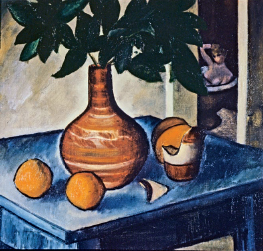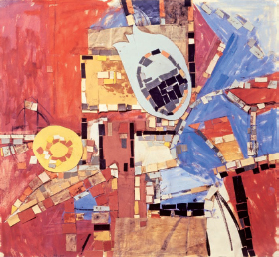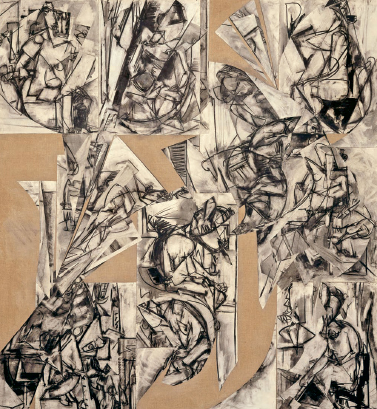
Krasner submitted this work from the previous summer to the committee at the National Academy of Design in order to be allowed to work from life models instead of casts. She was promoted in January 1929. CR 3 Self-portrait, 1928, the Jewish Museum, New York.

In this self-portrait, Krasner depicted herself in half-light, posing in the Brooklyn basement where she lived. Her friend, Eda Mirsky, acquired the painting and later presented it to t he Metropolitan Museum of Art. CR 1 Self-portrait, c. 1929, oil on canvas, 30½ x 32½ in. The Metropolitan Museum of Art, New York; Gift of Eda Mirsky Mann, 1988.

From 213 West Fourteenth Street, a building that offered access to the roof, Krasner briefly painted in a realist style close to that of Edward Hopper, who, two years earlier, painted City Roofs, depicting a similar view from his own roof. CR 17 Fourteenth Street, 1934, oil on canvas, 24¾ x 21¾ in. Pollock-Krasner Foundation, New York. Photograph courtesy of the Robert Miller Gallery.

Krasner admitted that some of her early paintings had “a slight touch of Surrealism.” Here she has already discovered the work of Joan Miró. CR 24 Gansevoort II, 1935, 25 x 27 in. Pollock-Krasner Foundation, New York. Photograph courtesy of the Robert Miller Gallery.

Krasner’s aim is intentionally erotic, signaled by the Cézannesque still life—two ripe oranges in the foreground evoke the nude’s round breasts and the broken pottery, like the broken eggs in Greuze’s still life, the woman’s lost virginity. CR 32 Bathroom Door, 1935, oil on linen, 20 x 22 in. Pollock-Krasner Foundation, New York. Photograph courtesy of the Robert Miller Gallery.

Her flat ground, as well as the placement and shapes of the separate objects tilted toward the picture plane, evoke Matisse’s Gourds of 1916, acquired by the Museum of Modern Art the same year she painted this homage. CR 33 Untitled (Still Life), 1935, oil on canvas, 20 x 28 in. Pollock-Krasner Foundation, New York. Photograph courtesy of the Robert Miller Gallery.

Krasner borrowed the motif of eyes from examples of fantastic art by Grandville and Redon, both featured in the MoMA exhibition “Fantastic Art, Dada, and Surrealism” that opened in 1936. CR 31 Untitled (Surrealist Composition), c. 1936–38, mixed media on blue paper, 12 x 9 in. Pollock-Krasner Foundation, New York. Photograph courtesy of the Robert Miller Gallery.

Working from a still-life setup at the Hofmann school, Krasner allowed the objects to dissolve into the surrounding space, creating an abstract composition animated by vibrations of colored shapes pushing and pulling against one another. CR 39 Untitled (Still Life), 1938, oil on paper, 19 x 25 in. Pollock-Krasner Foundation, New York. Photograph courtesy of the Robert Miller Gallery.

Mondrian’s geometric abstractions appealed to Krasner, who sometimes worked in a similar palette limited to the primary colors—red, yellow, and blue—plus black and white. CR 95 Red, White, Blue, Yellow, Black, 1939, oil on paper with collage, 25 x 191/8 in. Thyssen-Bornemìsza Collections.

With its jazz rhythm, emphasis on primary colors, and use of bits of colored paper to achieve an optical effect that vibrates, this seems unlikely to be related to anything but Mondrian’s work. CR 97 Mosaic Collage, c. 1942, paper collage on paper, 18 x 19½ in. Private collection. Photograph courtesy of the Robert Miller Gallery.

Forms were beginning to emerge from Krasner’s thick gray foundation that had previously threatened to absorb all her imagery as she sought to escape cubism. Pollock, Miró, or cave paintings influenced this primitive figure. CR 202 Image Surfacing, c. 1945, oil on linen, 27 x 21½ in. Pollock-Krasner Foundation, New York. Photograph courtesy of the Robert Miller Gallery.

The head of a rooster suggests the sexual metaphor of the cock who would attack other roosters where his hens were nesting. Igor had returned, hoping to reclaim Krasner, but with this work, she declared that she had moved on. CR 180 Igor, 1943, 18 x 247/8 in. Private collection.

Inspired by Pollock, Krasner now worked more from instinct than she had before. She also tried to be more at one with nature and developed her own all-over patterns of strokes with her palette knife and brush handle. CR 208 Untitled, 1946, oil on linen, 27¾ x 30¼ in. Pollock-Krasner Foundation, New York. Photograph courtesy of the Robert Miller Gallery.

One of Krasner’s “Little Image” paintings, which she said she produced horizontally and represented the only instances where she dripped paint. CR 212 Abstract No. 2, 1946–48, oil on canvas, 20½ x 23¼ in. IVAM, Institut Valencià d’Art Modern, Generalitat, Valencia, Spain.

Krasner’s originality led her to improvise with shells, pebbles, broken glass, keys, coins, and bits of costume jewelry. For the table’s frames, Krasner used an old iron wagon wheel. CR 218 Mosaic Table, 1947, mosaic and mixed media on wood, 46 in. diameter. Courtesy of Jason McCoy, Inc.

This is one of her largest “Little Image” series. It features dripped enamel paint, used by Pollock, who was inspired by the workshop of Siqueiros. CR 236 Continuum, 1947–49, oil and enamel on canvas, 53 x 42 in. Private collection.

This is one of the few surviving works from Krasner’s first solo show, held the same year at Betty Parson’s gallery. The vibrating geometric shapes recall her admiration of Mondrian’s work and her association with American Abstract Artists. CR 252 Number 2, 1951, oil on canvas, 92½ x 132 in. Pollock-Krasner Foundation, New York. Photograph courtesy of the Robert Miller Gallery.

In her show at the Stable Gallery, this and other dynamic collages won Krasner praise. CR 284 Burning Candles, 1955, oil, paper, cloth, and canvas collage on linen, 58 x 39 in. Collection of Neuberger Museum, State University of New York at Purchase; gift of Roy R. Neuberger.

Krasner, Pollock, and others considered this painting “scary.” It remained on her easel when she left for Europe in 1956, and she later acknowledged its figurative content. CR 302 Prophecy, 1956, oil on cotton duck, 58½ x 34 in. Private collection.

This painting, which recalls Matisse’s Bathers by a River of 1909–1910, may refer to Pollock’s earlier canvas, Two, of 1945. The third figure inserted between the male and female may refer to Ruth Kligman, who had intervened and threatened to split up Pollock and Krasner’s relationship. CR 305 Three in Two, 1956, oil on canvas, 75 x 58 in. Mr. and Mrs. Robert I. MacDonnell. Photograph courtesy of the Robert Miller Gallery.

The title Birth echoes that of Pollock’s painting, which Krasner admired in the January 1942 show at McMillan Gallery, where she too participated. Her return to this theme could suggest either her rebirth after Pollock’s death or her awareness that he had longed to have a child. CR 304 Birth, 1956, oil on canvas, 82½ x 48 in. Collection of Barbara B. Millhouse.

Krasner recalled that “tears were literally pouring down” when she painted these bright colors and biomorphic forms. They evoke a figure in a garden, an activity that she shared with Pollock after they first moved to Springs. CR 311 Listen, 1957, oil on cotton duck, 63¼ x 58½ in. Private collection. Photograph courtesy of the Robert Miller Gallery.

To name her picture, Krasner drew upon the opening lines of Emerson’s “Circles,” which had impressed her years before and appealed to her appreciation of nature and patterns. She had focused on disembodied eyes as early as the 1930s, under the influence of Surrealism. CR 350 The Eye Is the First Circle, 1960, oil on canvas, 92¾ x 1917/8 in. Private collection. Photograph courtesy of the Robert Miller Gallery.

The Springs pays homage to the hamlet in East Hampton where Krasner and Pollock made their home in 1945. The all-over pattern suggests reference to local flora and to Pollock’s 1946 series, “Sounds in the Grass.” CR 401 The Springs, 1964, oil on canvas, 431/8 x 661/8 in. The National Museum of Women in the Arts, Washington, D.C., gift of Wallace and Wilhelmina Holladay.

Krasner began to warm up the canvases of her umber series by adding warm reddish tones. These are among her most gestural paintings. CR 357 Double Helix, 1961, oil on canvas, 70½ x 62½ in. Private collection.

Among the colorful biomorphic shapes repeated across the wide canvas, it is possible to see what could be a bird form, however abstract, on the left side of the painting, which appears to allude to her difficulty in telling right from left. CR 431 Right Bird Left, 1965, oil on canvas, 70 x 135 in. Collection of Ball State University Museum of Art, Muncie, Indiana, gift of David T. Owsley.

Krasner named this painting Courtship, which was most likely an allusion to David Gibbs, whom one of her friends called “a charming cad.” CR 438 Courtship, 1966, oil on canvas, 51 x 71 in. Private collection.

This title recalls a myth: primordial Earth gave virgin birth to Sky (Uranos), who promptly cohabited with his mother to produce offspring called Titans. When Sky blocked his mother, Gaea, from giving birth to monsters, she conspired with their son, Kronos, who castrated his father. The painting’s agitated biomorphic forms in bright magenta suggested the violence of the title. CR 440 Gaea, 1966, oil on canvas, 69 x 120 in. The Museum of Modern Art, New York (Licensed by SCALA / Art Resource, NY and © 2010 The Pollock-Krasner Foundation), Artist’s Rights Society (ARS), New York. Kay Sage Tanguy Fund.

Krasner commented, “I can remember walking across vacant lots on my way to school and my enchantment at seeing and picking clover, buttercups, and dandelions. I’m sure that this memory among other things is in Pollination…” CR 449 Pollination, 1968, oil on canvas, 81¼ x 83 in. Dallas Museum of Art, gift of Mr. and Mrs. Algur H. Meadows and the Meadows Foundation, Incorporated.

The title, which refers to embryonic development that reproduces the ancestral features of the species, suggests Krasner’s deep engagement with nature, which remained of utmost importance to her throughout her life. The intense colors and crisp edges recall Matisse’s late work. CR 540 Palingenesis, 1971, oil on canvas, 82 x 134 in. Pollock-Krasner Foundation, New York. Photograph courtesy of the Robert Miller Gallery.

This work contains a number of rejected figurative drawings from her time at the Hofmann School. The title of the series reflects her fascination with time and the verb “to see” here she chose “Were you seeing?” CR 565 Imperfect Indicative, 1976, collage on canvas, 78 x 72 in. Pollock-Krasner Foundation, New York. Photograph courtesy of the Robert Miller Gallery.

Lee Krasner with Bill Lieberman at the 1967 retrospective of Jackson Pollock at the Museum of Modern Art, New York. Visible from left to right are Pollock’s Pasiphae (c. 1943), The She-Wolf (1943), and Guardians of the Secret (1943). Photograph by Steven Paley.

Mark Patiky is the only person to photograph Krasner while she painted. Patiky watched as she became very focused, standing back some fifteen feet with her arms folded, then running up and making “these slashing strokes,” a very active process, applied to unstretched canvas tacked to the wall. She is painting Portrait in Green (CR434), 1989.

Here, Krasner in front of her latest painting, which she had made for “Poets and Artists,” an invitational show of forty-two artist-poet collaborations scheduled for Guild Hall that July. Krasner had teamed up with poet Howard Moss, whom she knew well through their mutual friend, Edward Albee. Lee Krasner standing in front of Morning Glory, 1982, oil on canvas, 84 x 60 in. Photograph by Ann Chwatsky.